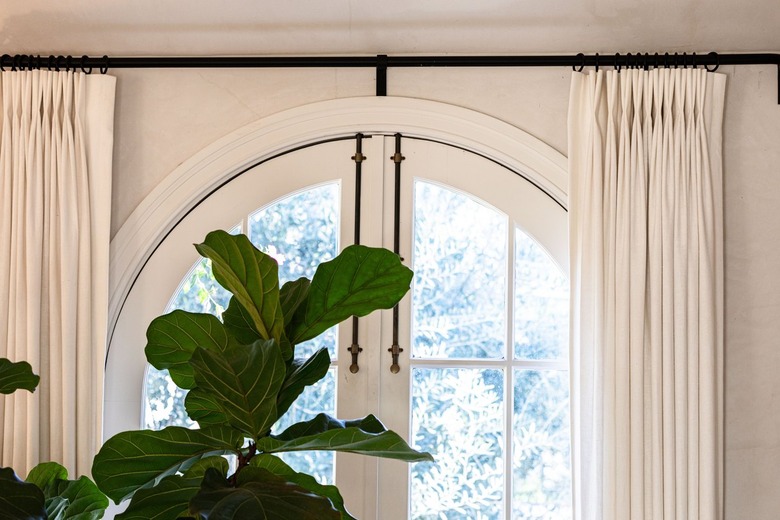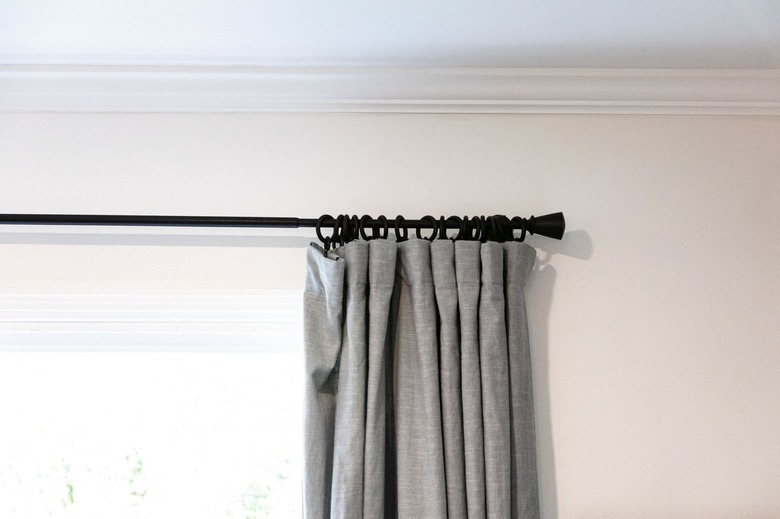How To Measure For Curtains And Drapes
We may receive a commission on purchases made from links.
Curtains and drapes are two of the most popular window treatments for several reasons — they can transform your home décor, they are easy to open and close, and they can provide some sound and thermal insulation (if desired). All three qualities are enhanced if the curtains are wider than the windows. If you hang curtains that just cover the window, you'll have to pull them flat, which looks the opposite of sophisticated and might cause problems as you struggle to eliminate gaps when closing them. If there are gaps, the curtains won't block light, heat, or sound.
Store-bought curtain panels come in standard widths and lengths, and as a general rule, you want to choose a size larger than what you need. The size of your window treatments depends on the size of the window, how much of the window and wall you want exposed when they are open, how far above the window you install the curtain rod, and how close to the ground you want them to hang.
Ready to buy some curtains or drapes? Here's how to measure your windows correctly to get the right size.
Curtains vs. Drapes
Curtains vs. Drapes
People tend to use the words "curtains" and "drapes" interchangeably, but they aren't the same. Curtains tend to be lightweight and sometimes sheer, they are often used in conjunction with blinds or shades, and curtain panels are usually sold in pairs. Drapes, on the other hand, are made of heavy, luxurious fabric and are sold in individual panels. Unlike curtains, which may be floor length or may hang only to the windowsill, drapes always hang all the way to the floor, either touching it, hovering just above it, or resting on the floor to form a puddle of fabric.
The heaviness of the fabric makes a difference when you're deciding how much space to leave on the sides of the windows. Heavy drapery fabrics take up more space than light curtain fabrics when they are open and bunched up next to the window frame, so you have to allow more room for heavy drapes. Also, drapes often have a liner or a pinch pleat, which means even more fabric and the need for more space.
Considerations When Measuring Window Width
Considerations When Measuring Window Width
When determining the width of the curtains or drapes you need, you start by measuring the area of the window. This is the actual area to be covered, but you'll also need space for the fabric when the drapes or curtains are open, and this can be from 4 to 12 inches or even more. The amount of extra space depends on the thickness of the fabric, whether you want the window completely or partially exposed when the curtains or drapes are open, and how much of the window trim and wall you want exposed.
Whatever your decision, you have to add the extra space to the total width of the window to determine the width of the panels. If you decide to allow, for example, 6 inches on either side of a 30-inch window, that adds 12 inches to the window measurement to make a total width of 42 inches to be covered. As a rule of thumb, the total width of the curtain panels should be twice the area to be covered — in this case, 84 inches. Store-bought panels typically come in 48-inch widths, so you would need two of them. You seldom get in trouble choosing panels that are wider than you need.
When hanging curtains in a window with an adjoining wall, you may be constrained by the distance between the window frame and the wall. Remember to leave room for the curtain rod finials by subtracting their length from the total available space plus a small amount (about an inch) for clearance between the finial and the wall.
Determining the Length of Curtains and Drapes
Determining the Length of Curtains and Drapes
To measure the length of drapes and curtains, you typically take a measurement from the floor to the position of the curtain rod, which can be anywhere from the top of the window trim to the ceiling, although the most standard height is 4 to 6 inches above the trim. Modifications to these measurements may be needed:
- If the style includes a tab top or loop header, add the length of the tab or loop to the total length. On the other hand, if the style includes a grommet or eyelet header, subtract the distance from the top of the hole to the top of the curtain. When using curtain hooks, subtract the distance between the point of insertion of the hooks and the top of the fabric. If you're hanging rod pocket curtains, no adjustment is necessary.
- Curtains and drapes come in standard lengths of 7, 8, 9, and 10 feet (84, 96, 108, and 120 inches), so if you want your store-bought window treatments to just touch the floor or hang an inch or two above it, you may have to modify them or adjust the height of the curtain rod. If moving the rod isn't possible (perhaps because you're constrained by a valance), purchase window treatments that are longer than you need and get them hemmed at the store or do it yourself. If you're hanging a heavy drapery or a blackout curtain and you don't plan to open and close them often, you have the option of letting the extra fabric rest on the floor.
How to Measure for Curtains and Drapes
How to Measure for Curtains and Drapes
The procedure for making drapery or curtain measurements can be summed up in a few simple steps. You'll need a stepladder and a sturdy metal tape measure that won't kink or bend.
1. Clear the Area Around the Window
Move all furniture away from the window to ensure an accurate measurement.
2. Measure the Width of Your Window
Hook the end of the tape measure to the outside of the window trim on one side, extend the tape across the entire window, and measure the distance to the outside of the trim on the other side. For windows without trim, such as those with drywall returns, measure the inside dimensions of the window frame. An easy way to do this is to measure the length of the windowsill from one side of the window frame to the other without counting any part of the sill that extends beyond the window frame.
3. Measure the Height of the Window
Hook the tape measure onto the outside edge of the top trim and extend it down to the sill. If the window has no trim, measure from the inside edge of the top of the frame to the top of the sill.
4. Measure the Distance to the Floor
Take a measurement of the distance from the bottom of the windowsill to the floor. Measure the thickness of the sill and add it to this measurement.
5. Measure the Distance to the Curtain Rod
Measure the distance from the top of the window to your preferred location for the curtain rod. This distance may change depending on whether you have to change the position of the rod to accommodate standard-length curtains or drapes.
6. Add the Height Measurements
Add the measurements for the height of the window, the distance from the sill to the floor, and the distance from the top of the window to the curtain rod to get the total length of the curtains or drapes you need.
References
- Linda Merrill: Design Details: How Wide Should My Drapery Panels Be?
- CurtainShop.com: How to Measure for Curtains
- YouTube: Half Price Drapes – Measuring Your Windows For Curtain Length & Width Made Simple
- The Shade Store: How To Measure For Curtains And Drapes
- Barn & Willow: This is the Real Difference Between Curtains and Drapes

